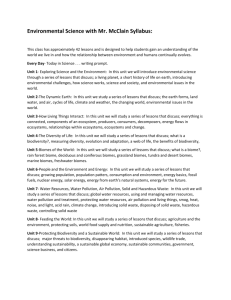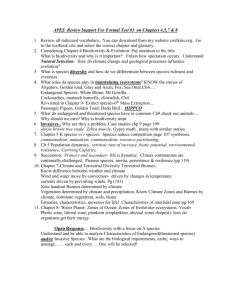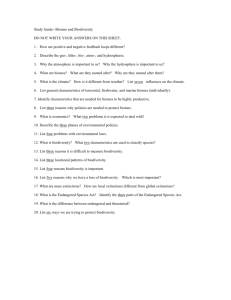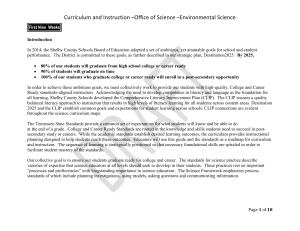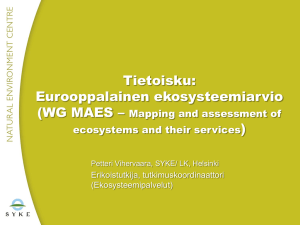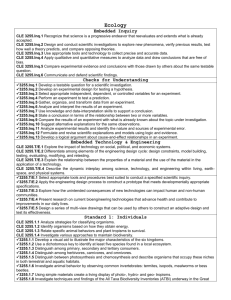Q2 - Shelby County Schools
advertisement
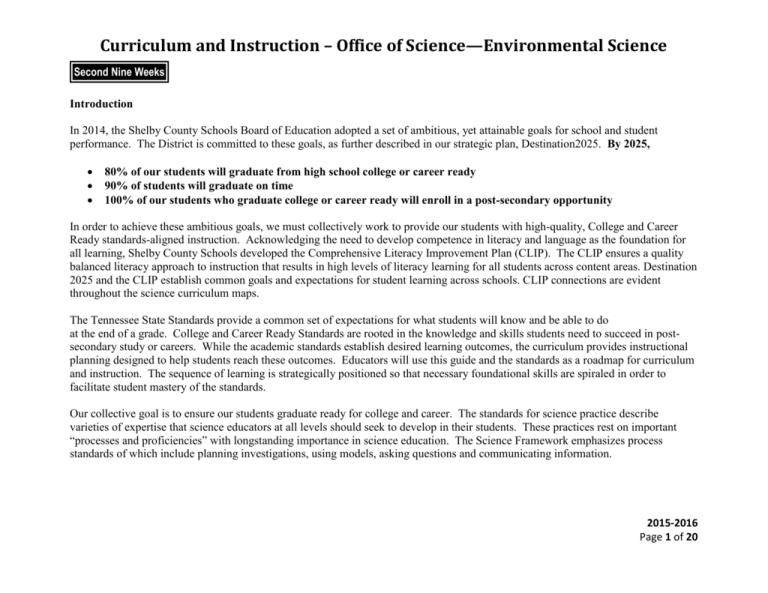
Curriculum and Instruction – Office of Science—Environmental Science Second Nine Weeks Introduction In 2014, the Shelby County Schools Board of Education adopted a set of ambitious, yet attainable goals for school and student performance. The District is committed to these goals, as further described in our strategic plan, Destination2025. By 2025, 80% of our students will graduate from high school college or career ready 90% of students will graduate on time 100% of our students who graduate college or career ready will enroll in a post-secondary opportunity In order to achieve these ambitious goals, we must collectively work to provide our students with high-quality, College and Career Ready standards-aligned instruction. Acknowledging the need to develop competence in literacy and language as the foundation for all learning, Shelby County Schools developed the Comprehensive Literacy Improvement Plan (CLIP). The CLIP ensures a quality balanced literacy approach to instruction that results in high levels of literacy learning for all students across content areas. Destination 2025 and the CLIP establish common goals and expectations for student learning across schools. CLIP connections are evident throughout the science curriculum maps. The Tennessee State Standards provide a common set of expectations for what students will know and be able to do at the end of a grade. College and Career Ready Standards are rooted in the knowledge and skills students need to succeed in postsecondary study or careers. While the academic standards establish desired learning outcomes, the curriculum provides instructional planning designed to help students reach these outcomes. Educators will use this guide and the standards as a roadmap for curriculum and instruction. The sequence of learning is strategically positioned so that necessary foundational skills are spiraled in order to facilitate student mastery of the standards. Our collective goal is to ensure our students graduate ready for college and career. The standards for science practice describe varieties of expertise that science educators at all levels should seek to develop in their students. These practices rest on important “processes and proficiencies” with longstanding importance in science education. The Science Framework emphasizes process standards of which include planning investigations, using models, asking questions and communicating information. 2015-2016 Page 1 of 20 Curriculum and Instruction – Office of Science—Environmental Science Second Nine Weeks Construct explanations and design solution Obtain, evaluate, and communicate information Engage in argument Ask questions and define problems Patterns Develop and use models Practices in Science Use math, technology, and computational thinking Plan and carry out investigations Cause and Effect Stability and change Cross Cutting Concepts Analyze and interpret data Energy and matter Systems and system models Crosscutting concepts have value because they provide students with connections and intellectual tools that are related across the differing areas of disciplinary content and can enrich their application of practices and their understanding of core ideas. Throughout the year, students should continue to develop proficiency with the eight science practices. Crosscutting concepts can help students better understand core ideas in science and engineering. When students encounter new phenomena, whether in a science lab, field trip, or on their own, they need mental tools to help engage in and come to understand the phenomena from a scientific point of view. Familiarity with crosscutting concepts can provide that perspective. A next step might be to simplify the phenomenon by thinking of it as a system and modeling its components and how they interact. In some cases it would be useful to study how energy and matter flow through the system, or to study how structure affects function (or malfunction). These preliminary studies may suggest explanations for the phenomena, which could be checked by predicting patterns that might emerge if the explanation is correct, and matching those predictions with those observed in the real world. 2015-2016 Page 2 of 20 Curriculum and Instruction – Office of Science—Environmental Science Second Nine Weeks Science Curriculum Maps This curriculum map is designed to help teachers make effective decisions about what science content to teach so that, our students will reach Destination 2025. To reach our collective student achievement goals, we know that teachers must change their instructional practice in alignment with the three College and Career Ready shifts in instruction for science. To ensure that all student will be taught science content and processes in a comprehensive, consistent, and coherent manner, Science Curriculum Maps are provided. Foundation texts for the maps include Shelby County Schools Framework for Standards Based Curriculum, Science Curriculum Frameworks-K-12 (State of Tennessee Board of Education, and National Science Education Standards). Teachers function most effectively and students learn best within an “aligned” curriculum delivery system. An aligned system begins with a concerted effort to implement the state curriculum frameworks. Many districts have developed curriculum guides built around these frameworks to ensure that what is taught in particular grades and courses is closely linked with student Learning Expectations found in the state standards. Classroom teachers use these locally-generated curriculum guides to plan and implement their individual grade or course Pacing Guides. Expectations for student performance are clear and carefully tied to daily instructional events and classroom assessment practices. In theory, a fully aligned system closes the loop between state standards and student learning. Additionally, a coherent instructional/assessment system offers the potential for heightening student learning as reflected by their performance on state-mandated standardized tests. Our collective goal is to ensure our students graduate ready for college and career. Most of the elements found in the state Curriculum Frameworks were incorporated into the curriculum mapping materials prepared by Shelby County Schools. Additional features were included to add clarity and to offer avenues that could assist teacher in developing grade level lessons. A district-wide, K-12, standards-based curriculum is implemented in science. This curriculum is articulated in the form of individual SCS curriculum maps for each grade and subject. These SCS curriculum maps enable the district to implement a single curriculum that emphasizes specific standards. Since Shelby County has a high rate of mobility among the student population, the SCS curriculum maps ensure that all students receive the same program of high-level instructional content and academic expectations, regardless of which school they attend. The utilization of a district-wide standards-based curricular program ensures that students in SCS are engaged in hands-on inquiry based activities as teachers implement the curriculum maps. 2015-2016 Page 3 of 20 Curriculum and Instruction – Office of Science—Environmental Science Second Nine Weeks Content CLE 3255.5.3 Examine the major marine and freshwater biomes. Embedded Standards CLE3260.Inq.1 Recognize that science is a progressive endeavor that reevaluates and extends what is already accepted. CLE 3260.Inq.3 Use appropriate tools and technology to collect precise and accurate data. CLE 3260.Inq.2 Design and conduct scientific investigations to explore new phenomena, verify previous results, test how well a theory predicts, and compare opposing theories. CLE 3260.Inq.4 Apply qualitative and quantitative measures to analyze data and draw conclusions that are free of bias. CLE.I 3260 Inq.6 Outcomes Adopted Resources Unit 2.1 Ecology/ Aquatic Ecosystems 1 Week HRW Chapter 7 – Aquatic Ecosystems pp. Research and create a visual to 184-197 summarize abiotic factors, location, 7.1 Freshwater Ecosystems plant adaptations, animal 7.2 Marine Ecosystems adaptations, and human threats to marine and freshwater biomes. Activities/Labs 1. Map Skills: Aquatic Diversity Describe the factors that determine where an organism lives in an Wetlands In The United States, 1780s vs. aquatic ecosystem. 1980s p.206 2. Case Study Restoration of the Chesapeake Bay pp. Describe the littoral zone and the benthic zone that make up a lake or 192-193 pond. Hurricane Katrina and New Orleans, p. 207 3. Exploration Labs: Describe two environmental functions Lab: Eutrophication: Too Much of a Good of wetlands. Thing, pp.204-205 Lab: Estuaries. p.192 Describe one threat against river Inferring Water Quality, CRF Ch.7 pp. 24-27 ecosystems. CBL Probeware: How Do Pollutants Affect a Lake?, CRF Ch. 7 pp. 32-37 Explain why an estuary is a very Recognizing Relationships: Temperature, productive ecosystem. Oxygen, and Bacteria, CRF Ch. 7 pp. 42-44 4. Group Activities: Compare salt marshes and Wetlands In Your Neighborhood p. 189 mangrove swamps. Save The Chesapeake Bay, p. 193 Coral Reefs, p. 195 Describe two threats to coral reefs. Marine Ecosystems, p. 196 CLIP Connections Academic Vocabulary Wetland, plankton, nekton, benthos, littoral zone, benthic zone, estuary, salt marsh, mangrove swamp, barrier island, coral reef Determine the central ideas or conclusions of a complex process, phenomenon, or concept; provide an accurate summary of the text. Active Reading: CRF Ch.7 Sect 7.1 and 7.2, cite the location of the answer, i.e. line, paragraph NGSS Practices: 8. Obtaining, evaluating, and communicating information Crosscutting Concepts: 1. Patterns 4. System and System 2015-2016 Page 4 of 20 Curriculum and Instruction – Office of Science—Environmental Science Second Nine Weeks Content Embedded Standards Communicate and defend scientific findings. Outcomes Adopted Resources CLIP Connections Models 6. Structure and Function 7. Stability and Change Core Ideas LS1.C. Organization for Matter and Energy Flow Teaching Resources In Organisms 1. Do Now Transparencies, CRF Ch. 7 Sect. 7.1 LS2.B. Cycles of Matter and 7.2 and Energy Transfer in 2. PowerPoint Presentations: Sect. 7.1 and 7.2 Ecosystems 3. Teaching Transparencies: Field Activity: Make A Miniature Aquatic Ecosystem, p. 196 Internet Activity: Wetland Plants, p. 188 Internet Activity: Tides and Estuaries, p. 193 6. Speaker: Wolf River Conservancy Describe two threats to ocean organisms. CLE 3260.Inq.5 Compare experimental evidence. CLE 3260.T/E.2 Differentiate among elements of the engineering design cycle: design constraints, model building, testing, evaluating, modifying, and retesting. Life Zones In A Lake Freshwater Wetlands In The United States The Formation of Estuary Coral Reefs Of The World Life Zones In The Ocean Chapter Review and Assessment 1. Section Reviews, p. 190 and p. 197 2. Chapter Review, pp 199-201 3. Standardized Test Prep, pp. 202-203 4. Concept Review, pp.1-2 5. Critical Thinking, pp. 3-6 Websites: 1. www.scilinks.org Lakes and Ponds HE 4058 Estuaries HE 4037 2. www.explorelearning.com Pond Ecosystem 2015-2016 Page 5 of 20 Curriculum and Instruction – Office of Science—Environmental Science Second Nine Weeks Content CLE 3255.2.1 Cite examples of populations limited by natural factors, humans or both. CLE 3255.3.1 Explain ecological niches within various habitats. CLE 3255.3.2 Relate species interactions such as competition, predation and symbiosis to co evolution survival. Embedded Standards Outcomes Adopted Resources http://www.aurumscience.com/env_science.html Aquatic Ecosystems Unit 2.2 Populations/Understanding Populations 2 Weeks Describe the three main properties HRW Chapter 8 – Understanding Populations CLE 3260.Inq.22 Design of a population. pp. 210-223 and conduct scientific 8.1 How Populations Change in Size investigations to explore Describe exponential population 8.2 How Species Interact with Each Other new phenomena, verify growth. previous results, test how Activities / Labs well a theory predicts and Describe how the reproductive 1. Map Skills: compare opposing behavior of individuals can affect the Tracking Cichlids theories. growth rate of their population. 2. Case Studies: Predator- Prey Adaptations, pp. 220-221 Explain how population sizes in Where Should The Wolves Roam, pp. 232nature are regulated. 233 3. Exploration Labs: Explain the difference between niche Studying Population Growth pp. 230-231 and habitat. Estimating Wild Animal Populations, CRF Ch. 8 pp. 24-27 Give examples of parts of a niche. CBL Probeware: Determining Growth Rate, CRF Ch. 8 pp. 28-35 Describe the five major types of Bug Off, CRF Ch. 8 pp.36-38 interactions between species. Calculating Generation Rate, CRF Ch. 8 pp. 39-43 Explain the difference between 4. Group Activities parasitism and predation. Two Types of Growth, p. 211 Constructing A Personal Niche Map, p. 217 Explain how symbiotic relationships Field Activity: Observing Competition, p.218 may evolve. Species Interaction Skit, p. 218 CLIP Connections Academic Vocabulary Population, density, dispersion, growth rate, reproductive potential, exponential growth, carrying capacity, niche, competition, predation, mutualism, commensalism, symbiosis Follow precisely a complex multistep procedure when carrying out experiments, taking measurements, or performing technical tasks, attending to special cases or exceptions defined in the text. 1. Active Reading: CRF Ch.8 Sect 8.1 and 8.2, cite the location of the answer, i.e. line, paragraph NGSS Practices: 1. Asking questions (for science) and defining 2015-2016 Page 6 of 20 Curriculum and Instruction – Office of Science—Environmental Science Second Nine Weeks Content Embedded Standards Outcomes Adopted Resources CLIP Connections Internet Activity: Restricted and Potential Niches, p. 219 Evolving Relationships, p. 222 Internet Activity: Island Carrying Capacities, p. 214 Teaching Resources 1. Do Now Transparencies, CRF Ch. 8 Sect. 8.1 and 8.2 2. PowerPoint Presentations: Sect. 8.1 and 8.2 3. Teaching Transparencies: Population Change and Exponential Growth Population Changes and Carrying Capacity Types of Species Interactions Niche Restriction Due To Competition Chapter Review and Assessment 1. Section Reviews, p. 216 and p.223 2. Chapter Review, pp. 225-227 3. Standardized Test Prep, pp.228-229 4. Concept Review, pp.1-2 5. Critical Thinking, pp. 3-6 Websites: 1. www.scilinks.org Populations and Communities, HE81192 Co evolution, HE80309 2. www.explorelearning.com Estimating Population Size Food Chain Rabbit Population by Season Rainfall and Bird Beaks problems (for engineering) 3. Planning and carrying out investigations 4. Analyzing and interpreting data 8. Obtaining, evaluating, and communicating information Crosscutting Concepts: 1. Patterns 2. Cause and Effect: Mechanism and Explanation 3. Scale, Proportion, and Quantity 6. Structure and Function 7. Stability and Change Core Ideas LS2.A Interdependent Relationships in Ecosystems LS2.D. Social Interactions and Group Behavior 2015-2016 Page 7 of 20 Curriculum and Instruction – Office of Science—Environmental Science Second Nine Weeks Content CLE 3260.3.1 Demonstrate how human population growth over time has been affected by improved food production, healthcare, sanitation and industrial advances. CLE 3260.3.2 Research demographics and economics status of countries to infer ecological and economic consequences of human population growth. CLE 3260.3.3 Explain how social and economic factors affect the fertility Embedded Standards . CLE 3260.Inq.5 Compare experimental evidence and conclusions with those drawn by others about the same testable question. CLE 3260.Inq.12 Develop a logical argument about cause-and-effect relationships in an experiment. CLE 3260.T/E.1 Explore the impact of technology on social, political, and economic systems. Outcomes Adopted Resources CLIP Connections 3. http://www.worldof7billion.org/teacher_resources 4. http://www.prb.org/Publications/LessonPlans/WorldPopulationDataSheet.aspx 5. http://www.aurumscience.com/env_science.html Species, Population, and Communities Unit 2.3 Populations/ The Human Population – 2 Weeks Describe how the size and growth HRW Chapter 9- The Human Population pp. rate of the human population has 234-247 9.1 Studying Human Populations changed in the last 200 years. 9.2 Changing Population Trends Define four properties that scientists use to predict population sizes. Make predictions about population trends based on age structure. Describe the four stages of the demographic transition. Explain why different countries may be at different stages of the demographic transition. Describe three problems caused Academic Vocabulary Demography, age structure, survivorship, fertility tube, migration, life expectancy, demographic transition, Activities / Labs infrastructure, arable land, 1. Map Skills: urbanization, least Fertility Rates and Female Literacy in Africa, developed countries p. 256 Synthesize information from Population Density a range of sources (e.g. 2. Case Study: texts, experiments, Thailand’s Population Challenges pp. 244simulations) into a coherent 245 understanding of a process, phenomenon, or 3. Exploration Labs: concept, resolving Studying Population Growth pp. 230-231 conflicting information when Estimating Wild Animal Populations, CRF possible Ch. 8 pp. 24-27 Vernier Probeware: Determining Growth Active Reading: CRF Ch.9 Rate, CRF Ch. 8 pp. 28-35 Sect 9.1 and 9. , cite the 2015-2016 Page 8 of 20 Curriculum and Instruction – Office of Science—Environmental Science Second Nine Weeks Content rate and life expectancy of the human population. Embedded Standards Outcomes by rapid human population growth. Compare population growth problems in more developed countries and less developed countries. Analyze strategies countries may use to reduce their population growth. Describe worldwide population projections into the next century. Adopted Resources Bug Off, CRF Ch. 8 pp.36-38 Calculating Generation Rate, CRF Ch. 8 pp. 39-43 5. Group Activities Growth Rates, p. 235 Modeling Infant Mortality, p. 238 Suburban, Metropolitan, Rural, or? p. 242 UN Population Goals, p. 246 Internet Activity: Demographic Data, p. 239 Field Activity: Does Your Local Area Have Population Pressured? P. 243 Teaching Resources 1. Do Now Transparencies, CRF Ch. 9 Sect. 9.1 and 9.2 2. PowerPoint Presentations: Sect. 9.1 and 9.2 3. Teaching Transparencies: Human Population Over Time Age Structure Diagrams Total Fertility Rate & Population Growth in the U.S. The Demographic Transition Worldwide Trends in Fertility & Population Growth Female Literacy & Fertility in Africa 4. Video: The People Bomb CLIP Connections location of the answer, i.e. line, paragraph NGSS Practices: 1. Asking questions (for science) and defining problems (for engineering) 4. Analyzing and interpreting data 5. Using mathematics and computational thinking 7. Engaging in argument from evidence 8. Obtaining, evaluating, and communicating information Crosscutting Concepts: 1. Patterns 2. Cause and Effect: Mechanism and Explanation 3. Scale, Proportion, and Quantity 6. Structure and Function 7. Stability and Change Chapter Review and Assessment 1. Section Reviews, p. 240 and p.247 2015-2016 Page 9 of 20 Curriculum and Instruction – Office of Science—Environmental Science Second Nine Weeks Content Embedded Standards Outcomes Adopted Resources CLIP Connections 2. Chapter Review, pp. 249-251 3. Standardized Test Prep, pp.252-253 4. Concept Review, CRF Ch. 9 pp.1-2 5. Critical Thinking, CRF Ch.9 pp. 3-6 Websites: 1. www.scilinks.org Demographic Transition HE 4018 Human Demographics HE 4056 Developed and Developing Countries HE 4021 2. http://www.populationeducation.org/content/findlesson 7 Billion: Where Do You Stand? A Hill of Beans A Matter of Timing A Nation of Immigrants All in the Family CLE 3255.1.4 Investigate various approaches to maintain biodiversity. CLE 3255.4.4 Summarize the human impact on ecosystems. CLE 3260.Inq.2 Design and conduct scientific investigations to explore new phenomena, verify previous results, test how well a theory predicts and compare opposing theories. Unit 2.4 Populations/Biodiversity --- 2 Weeks Describe the diversity of species HRW Chapter 10 - Biodiversity - pp. 258-275 types on Earth, relating the difference 10.1 What is Biodiversity? between known numbers and 10.2 Biodiversity at Risk estimated numbers. 10.3 The Future of Biodiversity Activities / Labs List and describe three levels of 1. Map Skills: biodiversity. Animal Ranges 2. Case Study: Academic Vocabulary Biodiversity, gene, keystone species, ecotourism, endangered species, threatened species, exotic species, poaching, endemic species, germ plasm, Endangered Species Act, 2015-2016 Page 10 of 20 Curriculum and Instruction – Office of Science—Environmental Science Second Nine Weeks Content CLE 3255.4.5 Describe how biodiversity relates to stability of an ecosystem. Embedded Standards CLE 3260.Inq.6 Communicate and defend scientific findings. Outcomes Explain four ways in which biodiversity is important to ecosystems and humans. CLE 3255.5.4 Infer how organisms in different biomes occupy similar niches. . CLE 3255.Inq.5 Compare experimental evidence and conclusions with those drawn by others about the same testable question. Analyze the potential value of a single species. CLE 3260.2. Discuss the roles of biodiversity and coevolution in ecosystems. Explain which types of threats are having the largest impact on biodiversity. Define and give examples of endangered and threatened species. Describe several ways that species are being threatened with extinction globally. List areas of the world that have high levels of biodiversity and many threats to species. Compare the amount of biodiversity in the United States to that of the rest of the world. List and describe four types of efforts to save individual species. Adopted Resources CLIP Connections A Genetic Gold Rush, pp. 266-267 3. Exploration Labs: Differences In Diversity, pp. 282-283 Comparing and Contrasting Organisms, CRF Ch. 10 pp. 27-30 Exploring Local Biodiversity, CRF Ch. 10 pp. 31-34 Modeling Diversity and Disease, CRF Ch. 10 pp. 40-45 Foreign Invasion, CRF Ch. 10 pp. 46-50 5. Group Activities Keystone Metaphor, p. 260 Public Perceptions, p. 264 Exotic Alert, p. 265 Special Bulletin, p. 265 Fun Park USA p. 270 Internet Activity: A Wild Pharmacy, p. 261 habitat conservation plan, Biodiversity Treaty Teaching Resources 1. Do Now Transparencies, CRF Ch. 10 Sect. 10.1, 10.2, and 10.3 2. PowerPoints Presentations: Sect. 10.1, 10.2 and 10.3 3. Teaching Transparencies: Known and Estimated Numbers of Species on Earth Sea Otters as an Example of a Keystone Species A Genetic Bottleneck RST.11-12.3.Follow precisely a complex multistep procedure when carrying out experiments, taking measurements, or performing technical tasks, attending to special cases or exceptions defined in the text. Compare and contrast findings presented in a text to those from other sources (including their own experiments), noting when the findings support or contradict previous explanations or accounts 1. Active Reading: CRF Ch.10 Sect 10.1, 10.2 and 10.3, cite the location of the answer, i.e. line, paragraph NGSS 2015-2016 Page 11 of 20 Curriculum and Instruction – Office of Science—Environmental Science Second Nine Weeks Content Embedded Standards Outcomes Adopted Resources Explain the advantages of protecting entire ecosystems rather than individual species. Describe the main provisions of the Endangered Species Act. Discuss ways in which efforts to protect endangered species can lead to controversy. Describe three examples of worldwide cooperative efforts to prevent extinctions. Biodiversity and Extinction Over Geologic Time Species Known to Be Threatened or Extinct Worldwide Global Biodiversity Hotspots Chapter Review and Assessment 1. Section Reviews, p. 262, p. 269, and p.275 2. Chapter Review, pp. 277-279 3. Standardized Test Prep, pp. 280-281 4. Concept Review, pp.1-2 5. Critical Thinking, pp. 3-6 Websites: 1. www.scilinks.org Endangered Species, HE80502 Preserving Ecosystems, HE 81214 Biodiversity HE 4005 Medicines from Plants HE4065 2. www.explorelearning.com Dichotomous Key 3. http://sciencenetlinks.com/lessons Preserving Health through Biological Diversity Biodiversity and Health .http://www.aurumscience.com/env_science.html What is Biodiversity? CLIP Connections Practices: 1. Asking questions (for science) and defining problems (for engineering) 4. Analyzing and interpreting data 7. Engaging in argument from evidence 8. Obtaining, evaluating, and communicating information Crosscutting Concepts: 1. Patterns 2. Cause and Effect: Mechanism and Explanation 3. Scale, Proportion, and Quantity 6. Structure and Function 7. Stability and Change 2015-2016 Page 12 of 20 Curriculum and Instruction – Office of Science—Environmental Science Second Nine Weeks Content Embedded Standards Examine common resource use practices in agriculture, forestry, urban/suburban development, mining, and fishing. CLE3260.Inq.12 Formulate and revise scientific explanations and models using logic and evidence. CLE3260.4.2 Explore best management policies related to water and soil resources. CLE3260.Inq.6 Communicate and defend scientific findings. CLE3260.4.3 Compare and contrast preservation and conservation. CLE3260.4.4 Evaluate the impact of human activities on natural resources. CLE 3260.Inq.5 Compare experimental evidence and conclusions with those drawn by others about the same testable question. Outcomes Adopted Resources Unit 2.5 Water, Air and Land/Water --- 1 Week Differentiate between renewable and HRW Chapter 11 Water pp. 288-313 non-renewable resources. 11.1 Water Resources 11.2 Water use and Management Summarize how environmental 11.3 Water Pollution problems ae associated with farming practices and soil conservation. Activities / Labs 1. Map Skills: Investigate the impact of the green Canada’s Water revolution on world food production 2. Case Study: and on the environment. The Ogallala Aquifer, pp. 292-293 The Three Gorges Dam, pp. 322-323 4. Exploration Labs: CBL Probeware: Testing Water Quality, CRF Ch. 11 pp. 37-42 Comparing Hard and Soft Water, CRF Ch. 11 pp. 43-46 Modeling Water Budgets, CRF Ch. 11 pp.32-36 Groundwater Filters, CRF Ch. 11 pp. 23-26 Operation Oil Spill Cleanup, CRF Ch. 11 pp. 27-31 5. Group Activities Why Can’t We Drink Salt Water? p. 291 Modeling An Aquifer, p. 294 Modeling Water Management Projects, p. 299 Identifying Sources of Pollution, p. 305 CLIP Connections Academic Vocabulary Surface water, river system, watershed, groundwater, aquifer, porosity, permeability, recharge zone, potable, pathogen, dam, reservoir, desalination, water pollution, point source pollution, nonpoint source pollution, wastewater, artificial eutrophication, thermal pollution, biomagnification 1. Active Reading: CRF Ch.11 Sect 11.1, 11.2, and 11.3, cite the location of the answer, i.e. line, paragraph interpreting data Core Ideas ESS2.C. The Role of Water in Earth’s Surface Processes ESS3.A. Natural Resources ESS3.B. Natural Hazards 2015-2016 Page 13 of 20 Curriculum and Instruction – Office of Science—Environmental Science Second Nine Weeks Content Embedded Standards Outcomes Adopted Resources CLIP Connections Mapping Pollution, p. 308 Artificial Eutrophication In A Fishbowl, p. 309 Demonstrating Bio-magnification, p. 312 Internet Activity: Researching Phosphates, p. 309 Teaching Resources 1. Do Now Transparencies, CRF Ch. 11 Sect. 11.1, 11.2, and 11.3 2. PowerPoints Presentations: Sect. 11.1, 11.2 and 11.3 3. Teaching Transparencies: Watershed Of The World Groundwater And The Water Table Drinking Water Treatment The Wasterwater Treatment Process How Pollutants Enter Groundwater Chapter Review and Assessment 1. Section Reviews, p. 295, p. 303, and p. 313 2. Chapter Review, pp. 315-317 3. Standardized Test Prep, pp. 318-319 4. Concept Review, pp.1-2 5. Critical Thinking, pp. 3-6 Websites: 1. www.scilinks.org Aquifers, HE80089 Water Conservation, HE81625 2015-2016 Page 14 of 20 Curriculum and Instruction – Office of Science—Environmental Science Second Nine Weeks Content Embedded Standards Outcomes Adopted Resources CLIP Connections Water Pollution, HE81629 2. www.explorelearning.com Water Cycle Water Pollution 3. http://thewaterproject.org/resources/lessonplans.php 4. http://www.seametrics.com/water-lessonplans 5. http://www.aurumscience.com/env_science.html Water pollution 2015-2016 Page 15 of 20 Curriculum and Instruction – Office of Science—Environmental Science Second Nine Weeks TOOLBOX Unit 2.1 Ecology/ Aquatic Ecosystems 1 Week Plans This plan provides an introduction to the concept of a biome with examples. Emphasis is on the relationship between climate, plant life, and animal life. http://www.lessonsnips.com/lesson/biomeworld Teachers can easily include an overview of biomes into their classrooms using some of the ideas for lesson plans at http://suite101.com/article/biome-lesson-plana181045 Teachers register for SmartNote Book, select SmartExchange, then search for lessons per topic for each chapter. You will have access to lessons that include objectives, Teacher notes, interactive lessons for the students, vocabulary, illustrations, animations, and closing questions. Information about the world’s major biomes: http://www.ucmp.berkeley.edu/exhibits/biomes/index.php Background for Teachers Student Activities Teachers and students can use the following site to learn more about terrestrial and aquatic biomes by clicking on the name of the biomes at http://bioexpedition.com/biomes/ The Biomes Project is an opportunity for you to do your own research on a particular biome. Your teacher may allow you to pick a biome, or he or she may select one for you. You will work in teams to research critical issues of your biome from different points of view. After your research, you will create a project to teach your classmates about the critical issues surrounding your biome. http://www.teachersfirst.com/lessons/biomes/project.php The latest research news is found at www.ScienceDaily.com. Enter the topic per the chapter and/or section to read the related stories, journals, watch featured videos, and a wealth of each is available. The articles have the save/print options. Archives of news are available with options of select 30 days, 90 days, 1, 5, and 10 year(s) options. Mobile options are iPhone, Android, and the Web. Additional access includes Facebook, Twitter, and Google+. Write your opinion, whether you agree or disagree with the news, and why? Other Resources Your mission, should you choose to accept it, is to investigate biomes, then test your knowledge about the biomes by completing each mission. http://earthobservatory.nasa.gov/Experiments/Biome/ Click on the name of a biome to learn about it, and then explore the additional links to a variety of resources. http://www.worldbiomes.com/default.htm Unit 2.2 Populations/Understanding Populations 2 Weeks 2015-2016 Page 16 of 20 Curriculum and Instruction – Office of Science—Environmental Science Second Nine Weeks TOOLBOX Plans Through a mix of modeling and direct instruction, learners are introduced to exponential data. They investigate the population of the United States using the TInspire calculator. Multiple data representations are used to explore aspects of the growing population. http://www.lessonplanet.com/teachers/lesson-plan-how-fastis-the-us-population-growing Students study patterns of population growth in an ecosystem and why populations must remain in balance. They interpret basic population graphs and suggest scenarios about different population growth patterns in an ecosystem. http://www.lessonplanet.com/teachers/lesson-plan-population-patterns Teachers register for SmartNote Book, select SmartExchange, then search for lessons per topic for each chapter. You will have access to lessons that include objectives, Teacher notes, interactive lessons for the students, vocabulary, illustrations, animations, and closing questions. Background for Teachers Student Activities Provides a general background on factors affecting population growth rate and some of the problems that may develop if a population grows too quickly. http://www.worldbank.org/depweb/english/modules/social/pgr/ A summary of population distribution patterns with links to related topics is provided at http://www.geography.learnontheinternet.co.uk/topics/popn1.html You will graph data on the Kaibab deer population of Arizona from 1905 to 1939, determine factors responsible for the changing populations and determine the carrying capacity of the Kaibab Plateau. http://biologycorner.com/worksheets/kaibab.html#.UbX26dibtkQ The latest research news is found at www.ScienceDaily.com. Enter the topic per the chapter and/or section to read the related stories, journals, watch featured videos, and a wealth of each is available. The articles have the save/print options. Archives of news are available with options of select 30 days, 90 days, 1, 5, and 10 year(s) options. Mobile options are iPhone, Android, and the Web. Additional access includes Facebook, Twitter, and Google+. Write your opinion, whether you agree or disagree with the news, and why? A population distribution match-up activity: http://www.geography.learnontheinternet.co.uk/activities/popn_distribution.html Other Resources What wiped out St. Matthew’s Island reindeer? http://www.alaskadispatch.com/article/what-wiped-out-st-matthew-islands-reindeer Unit 2.3 Populations/ The Human Population – 2 Weeks Plans Food for Thought is a spatial graphing activity that uses the participants as part of the graph. The activity helps students develop a feeling for the similarities and differences between populations. Many measures are used for comparison including population, population density, population growth rates, energy consumption, CO2 emissions, and more. http://www.prb.org/Educators/LessonPlans/2000/FoodforThought.aspx 2015-2016 Page 17 of 20 Curriculum and Instruction – Office of Science—Environmental Science Second Nine Weeks TOOLBOX This lesson plan includes three activities that allow students to: develop a working vocabulary for population geography; understand relationships and implications of demographic data; and construct and analyze population pyramids at different scales. Written for advanced high school students or may be adapted for other grade levels. http://www.prb.org/Educators/LessonPlans/2005/PopulationBuildingaFoundation.aspx Background for Teachers Teachers register for SmartNote Book, select SmartExchange, then search for lessons per topic for each chapter. You will have access to lessons that include objectives, Teacher notes, interactive lessons for the students, vocabulary, illustrations, animations, and closing questions. This article summarizes facts about population growth: http://www.encyclopedia.com/topic/Population_growth.aspx The following site contains links to many articles that focus on the global issue of population growth: http://www.globalissues.org/issue/198/human-population Student Activities GeoSim IntlPop is an applet that exposes students to the population growth and age distribution of selected countries and regions of the world. Population projections for each country can be simulated, and students may modify birth and death rates to investigate any resulting effects on the projected populations. http://geosim.cs.vt.edu/Java/IntlPop/IntlPop.html The latest research news is found at www.ScienceDaily.com. Enter the topic per the chapter and/or section to read the related stories, journals, watch featured videos, and a wealth of each is available. The articles have the save/print options. Archives of news are available with options to select 30 days, 90 days, 1, 5, and 10 year(s) options. Mobile options are iPhone, Android, and the Web. Additional access includes Facebook, Twitter, and Google+. Write your opinion, whether you agree or disagree with the news, and why? Using Avida-ED freeware, students control a few factors in an environment populated with digital organisms, and then compare how changing these factors affects population growth. They experiment by altering the environment size (similar to what is called carrying capacity, the maximum population size that an environment can normally sustain), the initial organism gestation rate, and the availability of resources. http://www.teachengineering.org/view_activity.php?url=collection/mis_/activities/mis_population/mis_population_activity1.xml Other Resources World population reaching seven billion is a great opportunity for you to incorporate environmental education and global studies into your classroom. The following teacher-friendly activities are classroom-ready and will get your students to actively engage in these timely issues. http://www.worldof7billion.org/teacher_resources While population growth in Vietnam in general and migration into this region more specifically played a role in deforestation, the series of events and the causes of 2015-2016 Page 18 of 20 Curriculum and Instruction – Office of Science—Environmental Science Second Nine Weeks TOOLBOX Plans deforestation end up being more complex than might first appear. This case study helps you investigate this situation and to make more nuanced conclusions and critiques of the theories presented in the conceptual framework. http://cgge.aag.org/PopulationandNaturalResources1e/CS_Vietnam_Sep10/index.html Unit 2.4 Populations/Biodiversity --- 2 Weeks The Schoolyard Biodiversity Investigation provides students with the opportunity to learn about biodiversity in a tangible and available environment – their own schoolyard. Download the teacher’s guide at http://www.fishwildlife.org/files/ConEd-Schoolyard-Biodiversity-Guide.pdf Background for Teachers Teachers register for SmartNote Book, select SmartExchange, then search for lessons per topic for each chapter. You will have access to lessons that include objectives, Teacher notes, interactive lessons for the students, vocabulary, illustrations, animations, and closing questions. Evidence from multiple ecosystems at a variety of temporal and spatial scales, suggests that biological diversity acts to stabilize ecosystem functioning in the face of environmental fluctuation. Learn more at http://www.nature.com/scitable/knowledge/library/biodiversity-and-ecosystem-stability-17059965 Student Activities In this unit we see how scientists measure biodiversity, how it benefits our species, and what trends might cause Earth's next mass extinction. Access this online textbook at http://www.learner.org/courses/envsci/unit/text.php?unit=9&secNum=0 This activity illustrates how to use math to calculate the diversity index of a selected habitat. The closer to 1 the diversity index is the more diverse and healthy the habitat is. This is a very simplified version of diversity index. The more accurate versions are called the Simpson and Shannon Indexes. http://www.accessexcellence.org/AE/ATG/data/released/0534-KathyParis/ The latest research news is found at www.ScienceDaily.com. Enter the topic per the chapter and/or section to read the related stories, journals, watch featured videos, and a wealth of each is available. The articles have the save/print options. Archives of news are available with options to select 30 days, 90 days, 1, 5, and 10 year(s) options. Mobile options are iPhone, Android, and the Web. Additional access includes Facebook, Twitter, and Google+. Write your opinion, whether you agree or disagree with the news, and why? Other Resources Plans Examine the role of biodiversity in ecological systems. A 30 minute video can be downloaded or viewed at the following website: http://www.learner.org/courses/biology/textbook/biodiv/index.html Read about biodiversity in a chapter from the online textbook Environmental Decision-Making, Science and Technology at http://telstar.ote.cmu.edu/environ/m3/s5/02biodiversity.shtml Unit 2.5 Water, Air and Land/Water --- 1 Week This lesson from Clemson University combines classroom work with a field trip to give middle school students hands-on experience in determining water quality. It may be modified for high school students. Go to the following site, scroll to the bottom of the page, and download Using Biotic and Abiotic Parameters to Monitor 2015-2016 Page 19 of 20 Curriculum and Instruction – Office of Science—Environmental Science Second Nine Weeks TOOLBOX Water Quality. http://www.clemson.edu/cafls/sclife/teacher_resources/lesson_plans.html Background for Teachers This module is part of "Exploring the Environment"ª (ETE) from NASA's Classroom of the Futureª. In ETE, high school students are faced with a real life problem and their goal is to use problem solving skills and internet-based data (e.g., remotely sensed satellite images) to propose and defend a solution. A Teacher's Guide is available. This link is to the ETE home page since it gives the easiest access to necessary introductory and teacher information. To access the water quality module, click on then "Water Quality" in the puzzle. http://ete.cet.edu/modules/modules.html How do harmful substances enter the body, and how do they damage cells? Learn how dangers are assessed, what kind of regulations we use to reduce exposures, and how we manage associated human health risks. Learn more at http://www.learner.org/courses/envsci/unit/text.php?unit=6&secNum=0 Teachers register for SmartNote Book, select SmartExchange, then search for lessons per topic for each chapter. You will have access to lessons that include objectives, Teacher notes, interactive lessons for the students, vocabulary, illustrations, animations, and closing questions. Student Activities Examine this plan for controlling pollution of Lake Pontchartrain in Louisiana and use it as a model for making your own plan for a local body of water. http://www.deq.louisiana.gov/portal/Default.aspx?tabid=1982 The latest research news is found at www.ScienceDaily.com. Enter the topic per the chapter and/or section to read the related stories, journals, watch featured videos, and a wealth of each is available. The articles have the save/print options. Archives of news are available with options to select 30 days, 90 days, 1, 5, and 10 year(s) options. Mobile options are iPhone, Android, and the Web. Additional access includes Facebook, Twitter, and Google+. Write your opinion, whether you agree or disagree with the news, and why? Other Resources MWRA's "Water Quality Testing Manual" is a field-based program appropriate middle school and high school students. It contains background information, lesson ideas, procedures, data collection and reporting forms, suggestions for interpreting the results and extension activities. http://www.mwra.state.ma.us/publications/waterqualitytesting/waterqualitymanual.htm 2015-2016 Page 20 of 20
